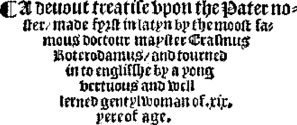Women as translators
One of the activities that was thought proper for literate women was the translation of devotional literature into English to make it more readily available for the improvement of the minds of other Englishwomen.
One such translator was Margaret Roper*, daughter of Sir Thomas More. She corresponded with the great humanist and friend of the family, Erasmus, who considered her the "ornament of Britain." Her published work was a translation of a work by Erasmus, A Devout Treatise upon the Paternoster;* in one of her father's letters there is mention of poems she had written, but they have not survived-- they were probably written in Latin, and may also have been translations.
More women translators
As early as the time of Margaret Beaufort, the mother of Henry VII, women were writing and translating. Beaufort founded schools, and endowed two colleges at Oxford.
Already mentioned in this section are Margaret Tyler and Mary (Sidney) Herbert; in addition, distinguished translations were made by Catherine of Aragon, and such writers as Anne Bacon, mother of Sir Francis; she gained an international reputation for her learning, and translated an important contemporary work justifying the Church of England (originally written in Latin, still the language of scholars, by Bishop Jewel).
Footnotes
-
A martyr's daughter
Margaret Roper is also remembered for an action of great courage. When her father was executed, and his head stuck on London Bridge, she took it down--an action that was illegal. Her integrity so impressed her judges that she was not condemned.
-
The Paternoster
The Lord's Prayer, so called from the opening words of it in Latin. The whole title-page (reproduced here) reads:
¶ A devout treatise vpon the Pater no-
ster/made fyrst in latyn by the moost fa-
mous doctour mayster Erasmus
Roterodamus/and tourned
into englisshe by a yong
vertuous and well
lerned gentylwoman of .xix.
yere of age.
